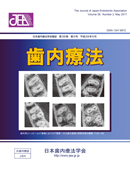Volume 41, Issue 3
Displaying 1-7 of 7 articles from this issue
- |<
- <
- 1
- >
- >|
Review Articles
-
2020 Volume 41 Issue 3 Pages 155-164
Published: 2020
Released on J-STAGE: October 15, 2020
Download PDF (12559K) -
2020 Volume 41 Issue 3 Pages 165-172
Published: 2020
Released on J-STAGE: October 15, 2020
Download PDF (4129K)
Original Articles
-
2020 Volume 41 Issue 3 Pages 173-178
Published: 2020
Released on J-STAGE: October 15, 2020
Download PDF (1471K) -
2020 Volume 41 Issue 3 Pages 179-184
Published: 2020
Released on J-STAGE: October 15, 2020
Download PDF (1066K)
Clinical Reports
-
2020 Volume 41 Issue 3 Pages 185-192
Published: 2020
Released on J-STAGE: October 15, 2020
Download PDF (4878K) -
2020 Volume 41 Issue 3 Pages 193-197
Published: 2020
Released on J-STAGE: October 15, 2020
Download PDF (1661K) -
2020 Volume 41 Issue 3 Pages 198-204
Published: 2020
Released on J-STAGE: October 15, 2020
Download PDF (12999K)
- |<
- <
- 1
- >
- >|
